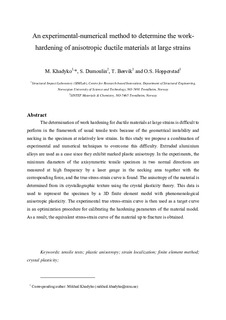| dc.contributor.author | Khadyko, Mikhail | |
| dc.contributor.author | Dumoulin, Stephane | |
| dc.contributor.author | Børvik, Tore | |
| dc.contributor.author | Hopperstad, Odd Sture | |
| dc.date.accessioned | 2017-10-06T11:12:55Z | |
| dc.date.available | 2017-10-06T11:12:55Z | |
| dc.date.created | 2014-08-27T14:16:44Z | |
| dc.date.issued | 2014 | |
| dc.identifier.citation | International Journal of Mechanical Sciences. 2014, 88 25-36. | nb_NO |
| dc.identifier.issn | 0020-7403 | |
| dc.identifier.uri | http://hdl.handle.net/11250/2458937 | |
| dc.description.abstract | The determination of work-hardening for ductile materials at large strains is difficult to perform in the framework of usual tensile tests because of the geometrical instability and necking in the specimen at relatively low strains. In this study, we propose a combination of experimental and numerical techniques to overcome this difficulty. Extruded aluminium alloys are used as a case since they exhibit marked plastic anisotropy. In the experiments, the minimum diameters of the axisymmetric tensile specimen in two normal directions are measured at high frequency by a laser gauge in the necking area together with the corresponding force, and the true stress-strain curve is found. The anisotropy of the material is determined from its crystallographic texture using the crystal plasticity theory. This data is used to represent the specimen by a 3D finite element model with phenomenological anisotropic plasticity. The experimental true stress-strain curve is then used as a target curve in an optimization procedure for calibrating the hardening parameters of the material model. As a result, the equivalent stress-strain curve of the material up to fracture is obtained. | nb_NO |
| dc.language.iso | eng | nb_NO |
| dc.publisher | Elsevier | nb_NO |
| dc.rights | Attribution-NonCommercial-NoDerivatives 4.0 Internasjonal | * |
| dc.rights.uri | http://creativecommons.org/licenses/by-nc-nd/4.0/deed.no | * |
| dc.title | An experimental-numerical method to determine the work-hardening of anisotropic ductile materials at large strains | nb_NO |
| dc.type | Journal article | nb_NO |
| dc.type | Peer reviewed | nb_NO |
| dc.description.version | acceptedVersion | nb_NO |
| dc.source.pagenumber | 25-36 | nb_NO |
| dc.source.volume | 88 | nb_NO |
| dc.source.journal | International Journal of Mechanical Sciences | nb_NO |
| dc.identifier.doi | 10.1016/j.ijmecsci.2014.07.001 | |
| dc.identifier.cristin | 1149815 | |
| dc.relation.project | Norges forskningsråd: 174834 | nb_NO |
| dc.description.localcode | © 2014. This is the authors’ accepted and refereed manuscript to the article. This manuscript version is made available under the CC-BY-NC-ND 4.0 license http://creativecommons.org/licenses/by-nc-nd/4.0/ | nb_NO |
| cristin.unitcode | 194,64,45,0 | |
| cristin.unitname | Institutt for konstruksjonsteknikk | |
| cristin.ispublished | true | |
| cristin.fulltext | postprint | |
| cristin.qualitycode | 1 | |

